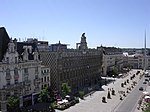Musée des Beaux-Arts de Valenciennes

The musée des beaux-arts de Valenciennes is a municipal museum in the French town of Valenciennes. Its collections originated as the collection of the Académie valenciennoise de peinture et de sculpture. It opened to the public for the first time in 1801 and was moved into the town hall in 1834. A competition to design a new building was held at the end of the 19th century, won by Paul Dusart. The new building was opened on 27 June 1909 and in 1995 was totally renovated and the display space expanded, with the addition of a basement displaying archaeological remains and artefacts. As well as paintings, it includes several sculptures by Jean-Baptiste Carpeaux (1827–1875), born in the town, as well as a prints and drawings department and
Excerpt from the Wikipedia article Musée des Beaux-Arts de Valenciennes (License: CC BY-SA 3.0, Authors, Images).Musée des Beaux-Arts de Valenciennes
Boulevard Watteau, Valenciennes
Geographical coordinates (GPS) Address Nearby Places Show on map
Geographical coordinates (GPS)
| Latitude | Longitude |
|---|---|
| N 50.35765 ° | E 3.5308 ° |
Address
Musée des Beaux-Arts
Boulevard Watteau
59300 Valenciennes, Faubourg de Paris
Hauts-de-France, France
Open on Google Maps









